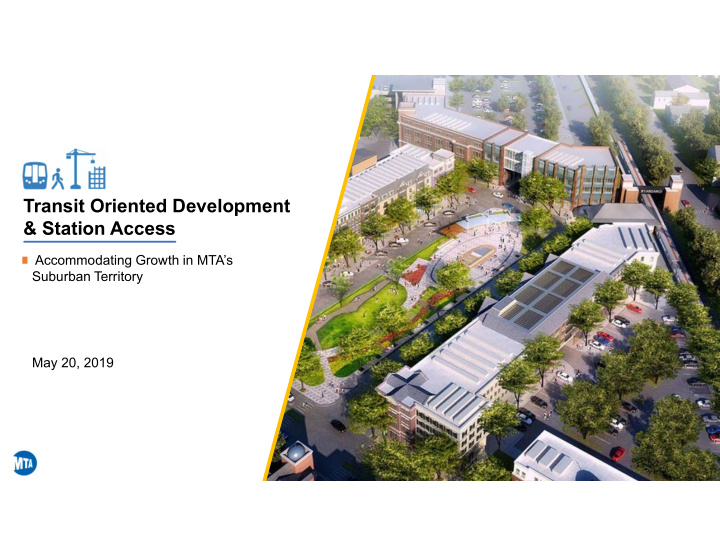



Transit Oriented Development & Station Access Accommodating Growth in MTA’s Suburban Territory May 20, 2019
TOD: Supports Transit Use, Creates Housing and Property Value Transit-Oriented Development – walkable, mixed-use development near MTA stations - will be the best means to accommodate future suburban growth. It does this in a sustainable fashion: • Increases transit use • Accommodates growth, minimizes sprawl • Creates real estate value • Benefits local communities • Reduces traffic on local streets • Meets required housing needs • Increases tax base Rendering: Mineola downtown development • Improves station-area neighborhoods 2
Land Use Near Stations Emphasizes Parking More than half of suburban commuters drive to station and park Parking Alternative Access 60% 50% 50% 40% 30% 20% MNR LIRR 10% 0% Drove Alone Carpool Drove Alone Carpooled Walking Drop‐Off Connecting Drop‐off Walking Services Connecting Service Current* AM Peak Access Modes • From 2017/ 2018 MNR Origin and Dest inat ion st udy and 2014 LIRR Origin and Dest inat ion S t udy 3
More Sprawl Creates New Parking Demand Multifamily units • Multi-family housing is now the built, in construction, or proposed within ½ mile of MTA suburban stations since 2016 primary form of suburban housing development MNR 35,000 • Despite an increasing desire to live 30,000 near stations, not enough TOD 25,000 housing is constructed 63% of all MNR units LIRR 20,000 are TOD units • Risk of “ high-density sprawl” which 15,000 26% of all LIRR units 10,000 creates new demand for station are TOD units 5,000 parking 0 Total Units TOD Units (53% of Total Units) 4
Most Commuter Parking is Municipally Controlled The maj ority of lots are municipally controlled. No. of Spaces MNR Municipal LIRR MTA Private 0 10,000 20,000 30,000 40,000 50,000 60,000 5
MTA TOD Opportunities are Limited Poughkeepsie Beacon Middletown/ Town of Wallkill Port Jefferson Harriman Ronkonkoma Westbury Babylon New Hyde Park Nanuet Port Chester, NY Mount Vernon East
MTA TOD at Harrison Station • Harrison S tation development will create apartments, retail shops and new commuter parking o 143 new apartments with residents who don’ t need dedicated station parking o Land value will finance additional commuter parking o The station area will be improved with retail shops, public space and station drop- Harrison Project: 143 new apartments, increase parking off areas capacity, upgrade pedestrian environment 7
Parkers walk Garage “ Wrapped” past retail with apartments This is what TOD New S tation Building with can look like retail amenities Town of Babylon replaced surface parking lots at Wyandanch station Retail street Drop off area in front of station Public open space is focal point Residential with mix of incomes 8
Regional TOD Leadership Encourage TOD at stations where MTA does not own land, promote j oint development of parking and other uses and facilitate alternative modes of station access. Village of Freeport: LIRR and Freeport will relocate commuter parking to facilitate a 250 unit TOD, 63 units will be dedicated senior housing Bay Shore: LIRR and Bay S hore are advancing a TOD proj ect that will create a new retail plaza and improve platform access Nanuet (Town of Clarkstown): Metro-North actively participated in the Town’s TOD Plan for Nanuet station and continues to coordinate with the Town as they work towards reviewing impacts of their Draft TOD zoning Port Chester : Rendering of MacQuesten’s 22 S West Street development in Mount The Village supports development near the station and has Vernon West, adjacent to station facilitated discussions concerning access improvements with Metro- North and developers 9
“First/Last Mile” Initiatives Should Complement TOD • • Counties and municipalities can encourage Physical and customer-related station area improvements should encourage drop off first/ last-mile solutions: and connecting services o Mobility-as-a-S ervice o Enhanced bus/ shuttle services Ingress/ egress Improvements o o NYMTC grant to create toolkit; identify Kiss & Ride o local pilot proj ect communities Pedestrian enhancements o 10
Key Takeaways • Park & Ride dominates today, but there are limitations and costs to continuing this model and the reliance on parking lots constrains growth. • Development adj acent to stations accommodates regional smart growth and generates local and MTA benefits • We need to partner with local governments to advance their land use policies • In working with local communities we need to encourage station access improvements and a variety of first mile-last mile approaches
Recommend
More recommend